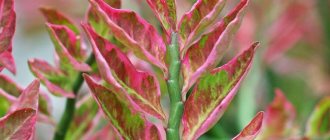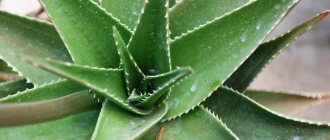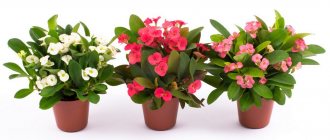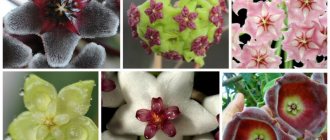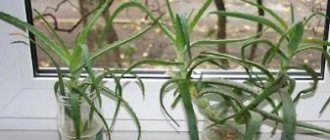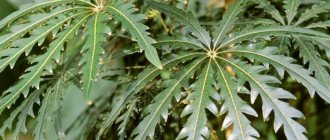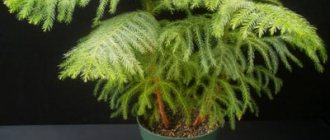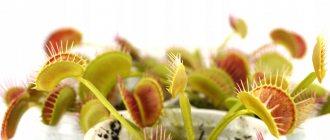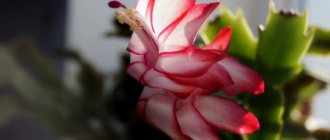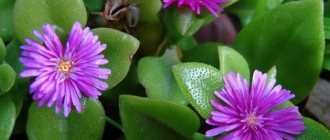What types of palm trees are there?
Let's take a closer look at the popular types of indoor palm plants and their features.
- Howea Forster...
- Hovea Belmora...
- Umbrella palm...
- Hamedorea graceful or bamboo palm...
- Cat palm...
- Rapis tall...
- Fishtail or soft caryota...
- Kariota pruriens
Apr 29
2015 Interesting materials:
How to calculate the average salary for an employment service? How to calculate the average salary for an employment center? How to sow mustard for fertilizer? How can I view my browser history if it has been cleared? How to see who is connected to iPhone? How can I see who is connected to my Beltelecom Wi-Fi? How to see who is connected to WiFi TP Link? How to set a high priority for a game? How to hang curtains If there is no room for a curtain rod? How to run in the morning to lose weight?
Description
The genus Dipsis belongs to the Palm family (Palmaceae), or Arecaceae (Arecaceae). It includes 162 varieties. Under natural conditions, these Palms grow in the humid forests of the Comoros and Madagascar. Dipsis is found in the tropical forests of Asia, Puerto Rico, El Salvador, the Antilles and Andaman Islands, Cuba, Haiti, and Jamaica.
Dipsis received the synonymous name Chrysalidocarpus for its fruits. Сhrysalides translated from Greek means “golden butterfly pupa”, karpus means “fruit”.
Palm trees of the genus are single-trunked or bushy. In nature they grow up to 10 m in height; in culture they are rarely higher than 3–5 m.
IN THE PHOTO: Dipsis plantings in exotic countries fascinate tourists.
The stem is smooth and green. When young it is as thin as a reed. As it matures, the stem thickens and resembles bamboo.
The leaves grow up to 2 m in length and 80–90 cm in width. This is the most decorative part of Dipsis, thanks to its interesting fan-dissected shape, leathery surface and unusual color. The light green tint of the leaf blade is aesthetically emphasized by the yellowish tone of the leaf sheath and petioles. There are small black scales on the petioles. Some cultivars have leaf petioles that are bluish or bright green.
IN THE PHOTO: Chrysalidocarpus leaf.
Inflorescences are paniculate, axillary, densely branched. The length of each inflorescence reaches 50–60 cm. In nature, Dipsis blooms in the spring and summer months, but rarely blooms indoors.
The fruits are small, round, golden yellow. The seeds are large, various shades of brown.
Dipsis seeds are used not only for plant propagation. Processed using special technologies, they turn into beautiful beads, interior rosaries and other aesthetic accessories.
Popular varieties
At home, yellowish Dipsis (Dypsis lutescens) is most often grown. This species is known as Areca Palm, Yellow Palm, Butterfly Palm. It is distinguished by a beautiful arched crown and original branched inflorescences with yellow flowers. The species was awarded by the Royal Horticultural Society.
IN THE PHOTO: Blooming yellowish Dipsis.
Dypsis madagascariensis is found in greenhouses and winter gardens. The highly decorative Palm is notable for its glossy feathery leaves and golden inflorescences.
IN THE PHOTO: The bright exotic foliage of Dipsis madagascaris simply cannot go unnoticed.
Interesting Facts
The Assyrians believe that the symbolic end of eternal life is the palm tree.
On Palm Sunday, 7 days before Easter, according to Christian rite, people carry palm branches in a symbolic ritual that depicted the triumphal entry of Jesus Christ into Jerusalem.
According to the Bible, people tore branches from palm trees, placing them in Jesus' path.
Franciscan missionaries are considered the first to plant palm trees for decorative purposes.
It is believed that the 1932 World Olympics in Los Angeles was the reason why palm trees were planted along the streets and in almost every public place in this city.
In ancient Babylon and Syria, dipsis personified the feminine principle, fertility and served the powerful goddess Ishtar.
Dipsis yellowish (Chrysalidocarpus yellowish, Areca yellowish)
Latin name: Dypsis lutescens (Chrysal />
Main genus: Dipsis
| Motherland |
|
| The soil |
|
| Size |
|
| Flowering time |
|
| Possible colors | |
| Illumination |
|
| Watering |
|
| Difficulty of care |
|
| Air humidity |
|
| Fertilizer frequency |
|
Growth:
Yellowish dipsis (Dypsis lutescens) originated in Madagascar and gradually expanded its range to mainland and island Africa. It grows on the sea coast and near rivers, on rocks and in sandy soil. Birds feast on fruits and carry seeds over impressive distances.
IN THE PHOTO: In countries with tropical and subtropical climates, Dipsis yellowish is grown in open ground.
In other regions - as a houseplant. Initially, the species was part of the Areca genus and was called the yellowing Areca flavescens. Later it was renamed Chrysalidocarpus lutescens. And although it has been officially called Dipsis yellowish since 2012, seeds and plants are often sold under alternative names.
Description of the plant:
Plant size and type:
The maximum height of a long-lived palm tree is 12 m. Even in the wild, growth, as a rule, stops at 6 meters, and when kept indoors it is three times less.
Dipsis yellowish is a multi-stemmed palm. Cylindrical trunks with a diameter of about 15 cm grow close to each other, are erect and slightly inclined. Green young stems change color to yellow as they mature.
IN THE PHOTO: Fallen leaves leave circle marks on the smooth surface, further enhancing the similarity of this palm tree to bamboo.
The long, feathery leaves are arched. On both sides of the rachis there are narrow leaves with a sharp tip. The yellowish petiole is decorated with small black spots. Yellow shades are also added to the green foliage.
IN THE PHOTO: Dipsis leaves are yellowish.
The palm tree blooms in spring and summer. Male and female flowers are found in a common inflorescence. Small pistillates are located between the stamens.
IN THE PHOTO: Most often, Dipsis yellowish flowers are yellow, sometimes mixed with cream.
After pollination, drupe fruits appear. They are round and elliptical with a diameter of 2–2.5 cm. As they ripen, they turn from green to yellow, red, and purple. Each fruit contains one seed in a hard shell.
Growing
Dipsis was cultivated en masse in the 80s. XX century The results of NASA research at that time showed that the plant effectively humidifies and purifies the air by filtering toluene and xylene. Such useful Dipsis “settled” in winter gardens, greenhouses, public halls, offices, houses and apartments.
In warm coastal regions, Chrysalidocarpus adorns outdoor landscape compositions. It looks impressive in single and group plantings.
To grow Dipsis indoors, you need a floor flowerpot, tub or pot of classic shapes, with a narrow bottom and a wide top.
The substrate for indoor Palm Trees consists of humus, leaf soil and sand in a ratio of 2:3:1. It is possible to plant or replant Dipsis in a ready-made substrate for Palm trees. For the soil drainage Dipsis needs, river pebbles, terracotta or gravel are added to the mixture.
Dipsis is demanding in terms of conditions of detention and care. The plant needs enough bright light. Therefore, Dipsis is placed in a bright place with a southeast or southwest orientation. Light partial shade is acceptable.
It is not recommended to keep Dipsis in direct sunlight. This leads to yellowing of the leaves and loss of decorativeness.
The optimal temperature is 22–25°C.
Dipsis is moisture-loving. The plant should be watered regularly and abundantly in the warm season, as soon as the top layer of soil dries out. For irrigation, only settled soft water is used. The palm tree is carefully watered from above.
In the cold months, watering becomes more moderate, but due to the absence of a pronounced dormant period, it does not stop.
For a healthy appearance of the above-ground part of the plant, constant humidification of the air nearby is required. Dipsis leaves should be regularly sprayed and washed with warm water.
Dipsis, like other palm trees, needs feeding. They are applied once a month from spring to autumn. In addition to complex fertilizers for Palm trees, Dipsis is suitable for feeding Dracaena and Yucca. The general principles of their use are described in the publication: “Using fertilizers for indoor plants.”
You will find useful tips on keeping Dipsis and other Arekovae in the article: “Growing indoor Palms.”
Preparing the soil and planting site
Dipsis, which is quite labor-intensive to care for at home, grows only in fertile, loose soil with a slightly acidic reaction. To plant it, you should use a special mixture intended for palm trees or citrus trees.
You can make the substrate yourself; you need to mix the following components:
- 4 parts turf soil:
- 2 parts leaf soil;
- 1 part humus;
- 1 part coarse sand.
The substrate must be sterilized, otherwise the dipsis will die from pests and microbes living in the soil.
This can be done in different ways:
- Warming up in the oven. The earth mixture should be evenly distributed over the surface of the baking sheet, in a layer of up to 5 cm. The substrate should be well moistened with hot water. The mold must be placed in an oven preheated to 90°C. It will take 30-45 minutes to disinfect the soil.
- Steam treatment. The sieve should be covered with gauze folded in 2-3 layers. There is no need to pour substrate on it. The structure must be placed on a bucket of boiling water. Covering the soil with a lid, you will need to warm it up for 90 minutes. During the process, it is worth stirring the substrate 3-4 times so that it is evenly sterilized.
In addition to the soil for planting palm trees, you need to prepare drainage. For this purpose, you can use small river pebbles, expanded clay or clay shards. You should choose a pot for dipsis that is stable, and its diameter should exceed the volume of the roots by 3-4 cm. It is important that there is a drainage hole in the pot.
As for the material, you can use ceramic, plastic or wooden containers. But it is better to choose flowerpots of a light shade, then the roots will not overheat in the summer. Before planting, the container should be thoroughly washed with laundry soap and then doused with boiling water.
Diseases and pests
Dipsis is harmed by scale insects, mealybugs, and mites. Modern insectoacaricides will help to cope with pests and prevent the appearance of insects and mites: Aktara, Karbofos, Aktofit, Vermitek.
If not properly cared for, Dipsis is affected by leaf spot, root rot, fusarium, anthracnose, and other fungal and bacterial diseases.
IN THE PHOTO: Brown spotting of palm leaves.
You can prevent infection by pathogens or cure the plant using fungicides: Fundazol, Topaz, Abiga-Pik. It is recommended to treat Dipsis planting material with Maxim.
The main pests of neodypsis
The biggest problems when growing palm trees are caused by mites, mealybugs and thrips.
- Ticks
of various types usually attack the plant in early spring. It is almost impossible to detect them with the naked eye, but the result of their vital activity quickly becomes noticeable. Small dotted spots of yellow, brown or brown hue form on neodipsis leaves. Ticks actively move to neighboring plants, so in case of disease, treatment and preventive methods should be applied to all flowerpots in the house. To combat ticks, insecticide solutions are used. Leaves and stems of plants are sprayed for 3-4 days, then repeated after a week. After this, using a magnifying glass, you need to carefully examine the plant and, if mites are found, carry out the spraying procedure again. - The scale insect
settles in the axils of dipsis leaves, and is easy to spot by its characteristic white coating. To combat it, the affected areas are wiped with a sponge, which is pre-moistened in an alcohol solution. If this gentle method does not help, then you will need to treat the leaves with insecticides. - Signs of thrips
are the appearance of a silvery sheen and brown spots on the bottom of the leaf. The insect is afraid of moisture, so high humidity prevents its appearance. If thrips does settle, then to combat it, the leaves are wiped with an alcohol solution and a composition of soap foam and ash.
For more useful information about transplanting chrysalidocarpus, watch this video:
Features of palm trees of the genus Dipsis
Due to its aesthetic appearance, the yellowish chrysalidocarpus was awarded by the Royal Horticultural Society. However, the palm tree became widespread after special research organized by NASA scientists. The purpose of the tests was to find out which plants can bring the greatest benefits when grown at home. As a result, it was found that dipsis removes dangerous gases of toluene and xylene from the air, while simultaneously enriching it with oxygen and increasing humidity.
Temperature and ventilation
Chrysalidocarpus does not tolerate hot temperatures well; at temperatures above 25 degrees it is extremely sensitive to the slightest fluctuations in air humidity and insufficient ventilation. The optimal range of indicators is from 18 to 22 degrees Celsius, with an acceptable short-term minimum of 16 degrees. In the cold season, it is better to place the palm tree on stands to protect the pots from hypothermia.
This heat-loving palm tree can only be taken out onto the balcony or into the garden with control and protection against temperatures dropping below 16 degrees. But for normal development, a sufficiently large volume of air is needed in the room. Frequent ventilation is mandatory for chrysalidocarpus, even if the plant does not tolerate direct and cold drafts.
Common Dipsis Diseases
If you do not follow the rules of caring for the plant, the leaves of neodipsis may become stained and dry out. Depending on the lack of certain attention, the following external signs appear:
- if brown spots are noticed on the leaves, this is usually a consequence of excess moisture, low temperature or extremely high water hardness;
- when the leaves at the base of a palm tree turn brown, in most cases this is a consequence of the natural aging process;
- if only the tips of the leaves dry out and turn brown, this indicates a low level of air humidity or lack of moisture in the soil;
- the rounded shape of the dark spots that appear on the leaves most likely indicates sunburn, so the plant should be placed in the shade, avoiding the harmful effects of ultraviolet radiation.
The following dangerous diseases may occur due to improper care.
- Overwatering can lead to root rot
. Symptoms include yellowing of the leaves, which darken over time and the dipsis dies. If, against the background of the onset of the disease, the temperature drops or there is a lack of useful minerals in the soil, the disease will progress rapidly and then it will become impossible to save the plant. Root rot can only be combated in the early stages, when the neodipsis is transplanted into another pot, while cutting off the affected areas of the roots. Before planting in new soil, the roots are immersed in a solution with a fungicide for 20–25 minutes. In places where the roots are cut, the wounds are sprinkled with ash or cinnamon, after which the dipsis is planted in disinfected soil. Then the plant is watered twice with a fungicide solution. - Often young leaves suffer from penicillium
, which usually affects the tip of neodypsis. The first sign of the disease is the appearance of small necrotic spots. Over time, they grow and the presence of a whitish coating can be detected in infected areas. It is left behind by fungal spores, under the influence of which the palm leaves lose their natural shape. A fungal infection always originates and develops in the soil, and only then moves directly to the plant itself. - In addition to penicillosis, dipsis can also be attacked by other fungal infections
. An indicator of their appearance are the leaves of the plant, on which lonely spots of various shapes and shades appear. If a palm tree is over-watered, it serves as a catalyst to accelerate the development of fungus, which quickly spreads to the stems and leaves. To combat it, use a fungicide solution, which is sprayed on all affected areas 2-3 times a day.
Reproduction of Neodypsis in an apartment or office
To obtain a new palm plant from the genus Dipsis, it is possible by separating daughter shoots or planting seeds. The latter method requires patience, since the seeds take a fairly long period of time to germinate, taking 3–4 months. In order for the palm tree to grow lush and beautiful, a small group of seeds is usually sown in one pot of peat. Before planting, they are pre-soaked in water at a temperature of 30 degrees for 3 days, and after planting, they need to be provided with enough light, moisture and an appropriate temperature of 23-25 degrees.
If the first method is used, then it is necessary to collect the adventitious buds that appear there at the base of the stem, which are then transplanted into separate pots with light soil.
Care
Dipsis cannot be called an unpretentious plant.
And in order to grow a plant at home, you will need to provide it with careful care, which consists of the following agrotechnical measures:
- regular watering;
- frequent spraying;
- feeding;
- pruning;
- transplants as they grow.
It is also necessary to maintain a certain temperature, humidity and lighting level near the crop. And in some cases it will be necessary to fight diseases and pests that can attack the palm tree.
Spraying and watering
Dipsis is a moisture-loving plant and needs regular watering. And the substrate should be moistened immediately as soon as it dries to a depth of 2-3 cm.
It is better to use melt water for irrigation. But if this is not possible, then tap water will do. But before that, it should be filtered and infused for at least a day. It is also better to warm the water slightly. It is advisable to add citric acid (1 g per 1 l) to soften it.
Palm trees do not tolerate stagnation of moisture at the roots. And 1-2 hours after watering, it is important to remove excess moisture from the pan. Otherwise, the roots of the culture will rot and it will die.
Dipsis, home care consists of regular watering; you will also need to spray it frequently. It is especially important to carry out this procedure in winter, when the air becomes very dry due to the operation of heating devices.
You can also install a special device near the palm tree - a humidifier, which will create comfortable conditions for the plant. But even if it is present, you should regularly wipe the foliage of the crop with a damp sponge to remove dust from it.
Top dressing
Dipsis needs regular feeding. And you will need to fertilize the soil 2 times a month, from the beginning of April to the end of August. For feeding, it is worth using mineral complexes intended for palms, ficuses and dracaenas. The drugs “Bona Forte”, “Kristalon”, “Agricol” are suitable.
Trimming
To make Dipsis look as well-groomed as possible, it is important to regularly remove all dried and damaged leaves. But they need to be cut off when the petiole dries out.
You should also remove excess side shoots, otherwise the main stem will stop developing. Pruning can be done at any time of the year. But in the process it is important to use a sharp and sterilized instrument.
Transfer
Dipsis, which takes a lot of time to care for at home, grows over time, and it becomes cramped in an old pot. So the plant will need to be transplanted into a larger pot. You can tell that this procedure needs to be carried out by looking at the roots sticking out of the drainage holes.
On average, young palm trees will need to be replanted every year. For older specimens, this event should be carried out once every 2-3 years. Large palm trees should not be replanted, but every year they will need to change the top layer of soil to a depth of 5 cm.
Transplantation of dipsis yellowish.
For the procedure, you need to prepare a pot whose diameter is 5 cm larger than the previous one. You also need to purchase or make a substrate with the same composition that was used when planting the plant. Drainage is also necessary (expanded clay, perlite, clay shards or polystyrene foam).
The transplant should be carried out according to the following algorithm:
- A layer of drainage, 3-4 cm thick, should be poured onto the bottom of the new pot. The material should be sprinkled with fertile soil.
- The palm tree needs to be watered well, and when the moisture is absorbed, remove it from the old flowerpot. Next, you should superficially examine its roots. If there are rotten shoots, then you should carefully rinse the entire mass from the old earthen lump. Using a sharp and disinfected knife, it is necessary to cut out the damaged roots, capturing 2-3 cm of healthy tissue. The cut areas need to be sprinkled with crushed charcoal. If the roots of the plant look healthy, then they do not need to be freed from the old earthen clod.
- Dipsis should be placed in the center of the new flowerpot and sprinkled with sterilized soil. To prevent voids from forming during the process, you need to gently knock on the walls of the pot. It is important that the root collar of the plant is at the same level with the ground as before.
- The soil needs to be well watered with warm water, pouring it under the walls of the container.
After transplantation, the dipsis should be kept in partial shade for 7 days, and only then returned to its usual place.
Optimal conditions
Dipsis is a heat-loving, tropical plant. And it is better to grow it at year-round temperatures within +27...+35 °C. In this case, it is desirable that the soil be warmed up to 21...+27 °C. Dipsis can easily withstand even more intense heat, but its frost resistance is low.
Thus, the development of the plant stops already at +18 °C, and at 0 °C it dies.
Dipsis is a light-loving plant, but the midday rays of the sun harm it. So it is better to keep the plant near eastern or southern windows, while shading it from 11:00 to 15:00. True, this will only need to be done on summer days. It is better to keep young palm trees in more shaded areas, as strong sun causes the foliage to burn and die.
Reproduction
Dipsis propagates by seeds and cuttings.
Seed germination is high. Seeds are sown in spring or summer in a substrate containing sand, peat and chopped sphagnum moss. To germinate Dipsis seeds, constant heating of the soil will be required. For this reason, it is recommended to sow them in an indoor greenhouse.
IN THE PHOTO: This is what Dipsis seeds look like.
Shoots appear after 30–40 days. For further growth they need a temperature of +18–22°C.
To propagate Dipsis by daughter offspring, you need to carefully separate the shoots with formed roots from the adventitious buds. This is done during plant transplantation.
The cuttings are planted in soil suitable for young Dipsis. Composition: two parts humus, one part humus, one part each of leaf soil and compost. Planted cuttings are watered abundantly and placed in a warm place for germination.
